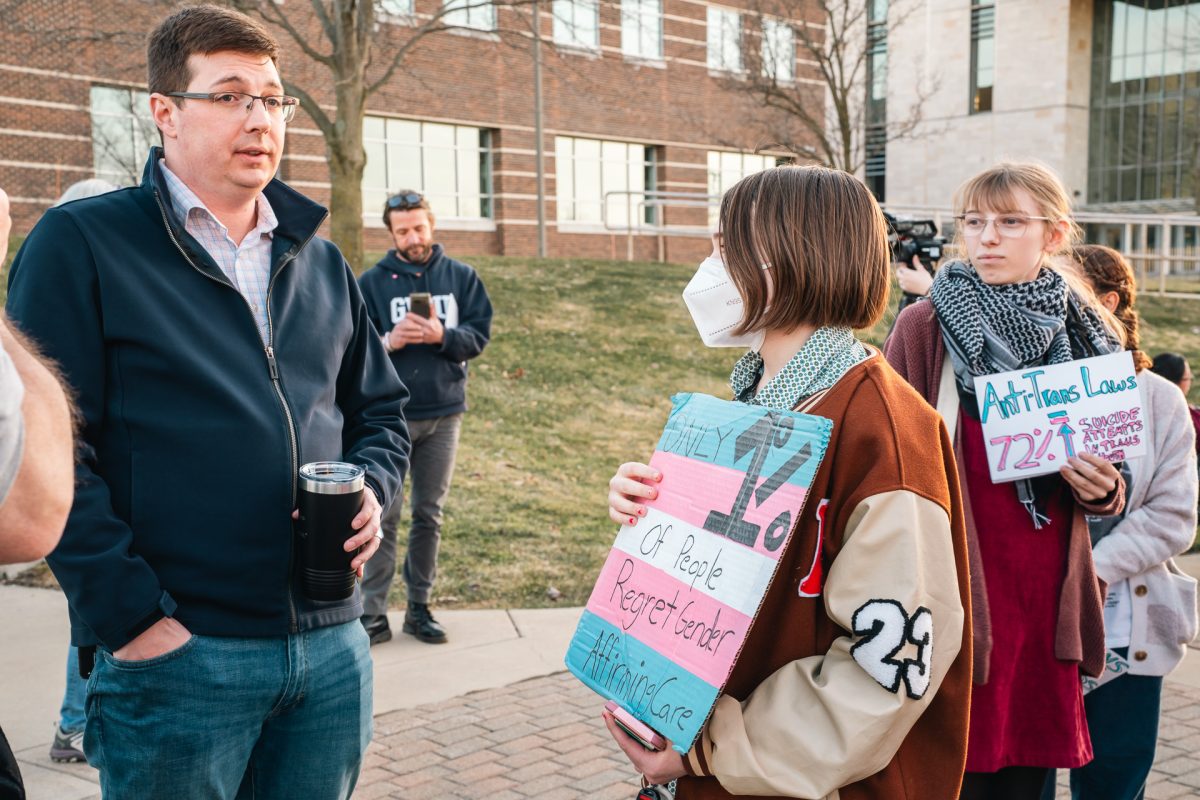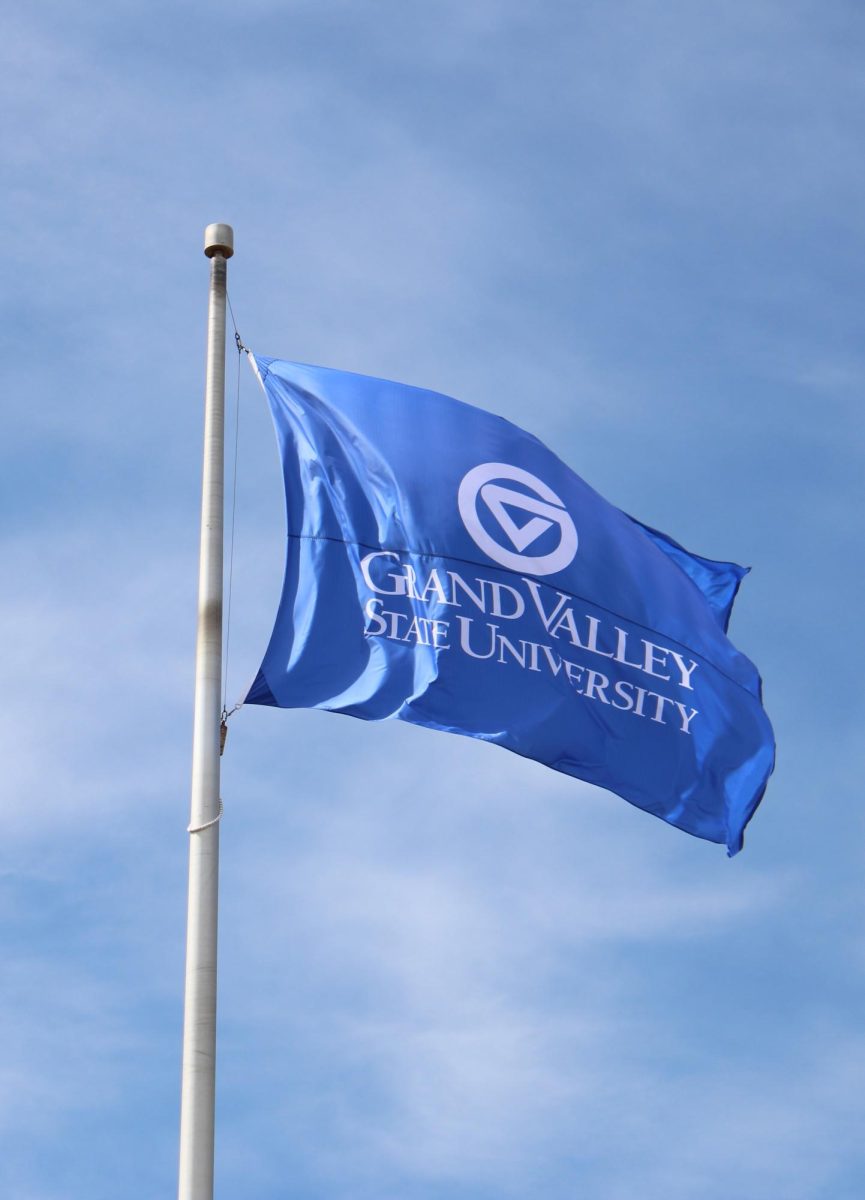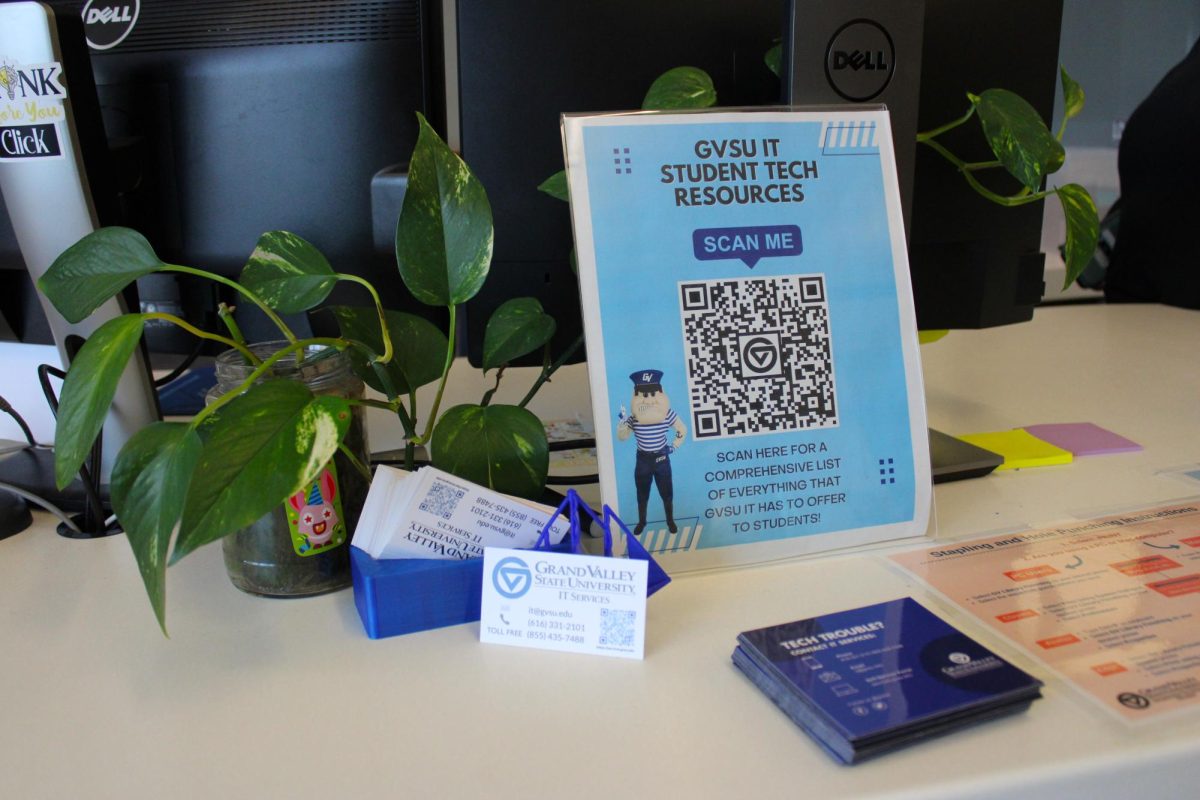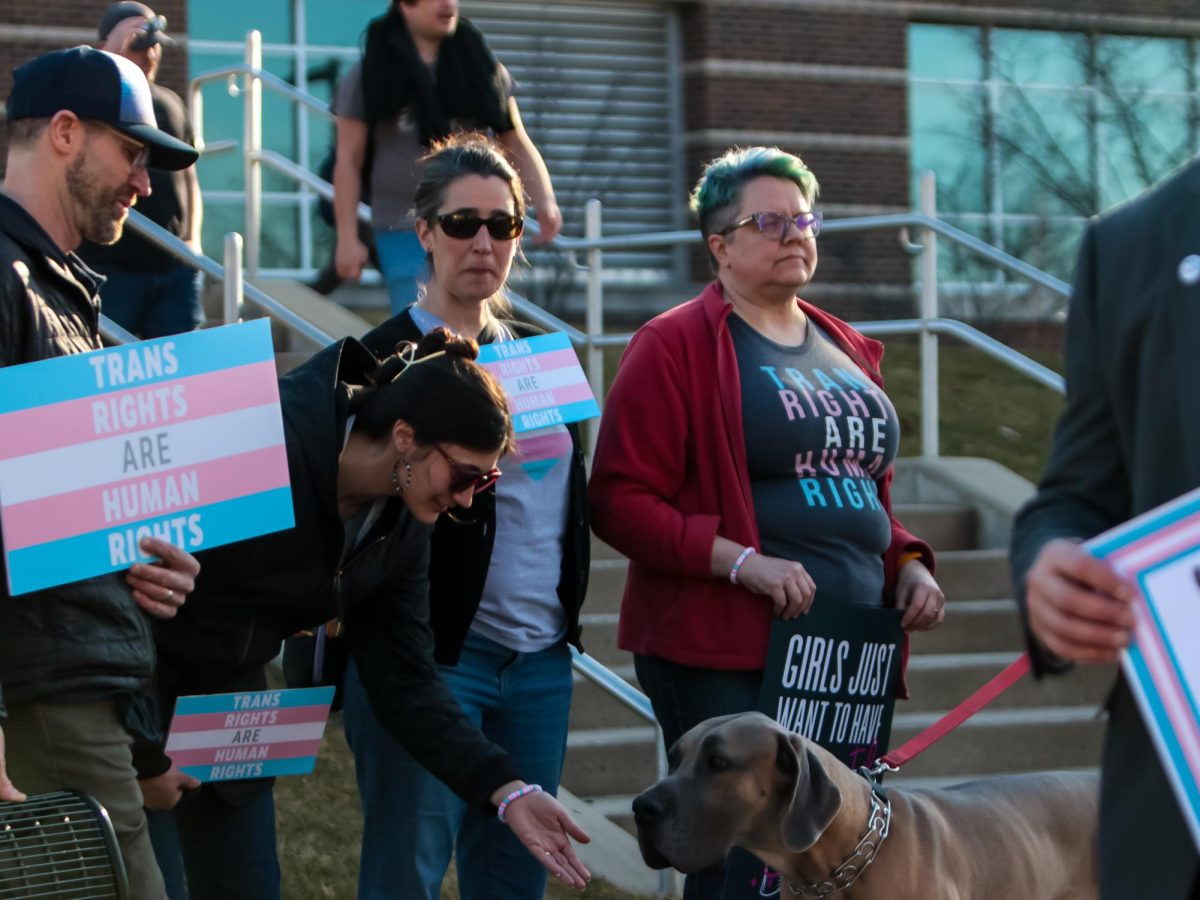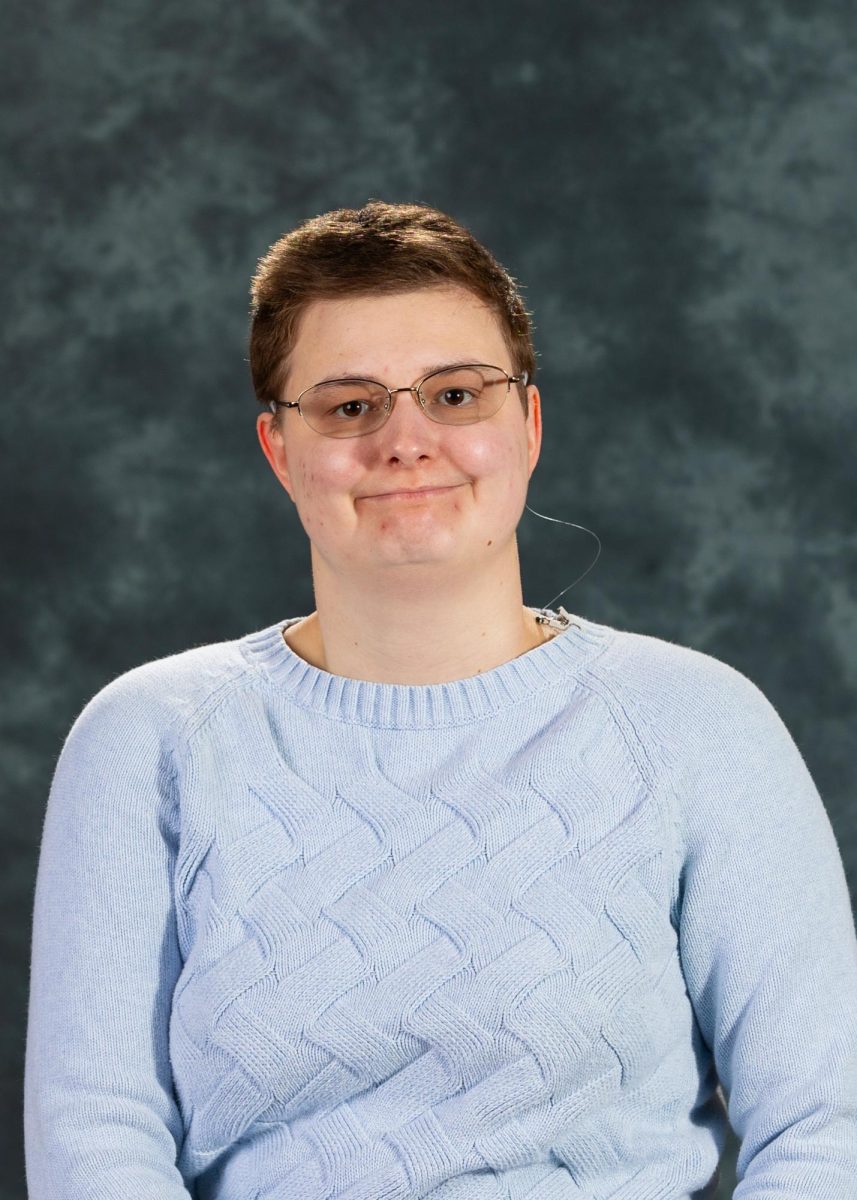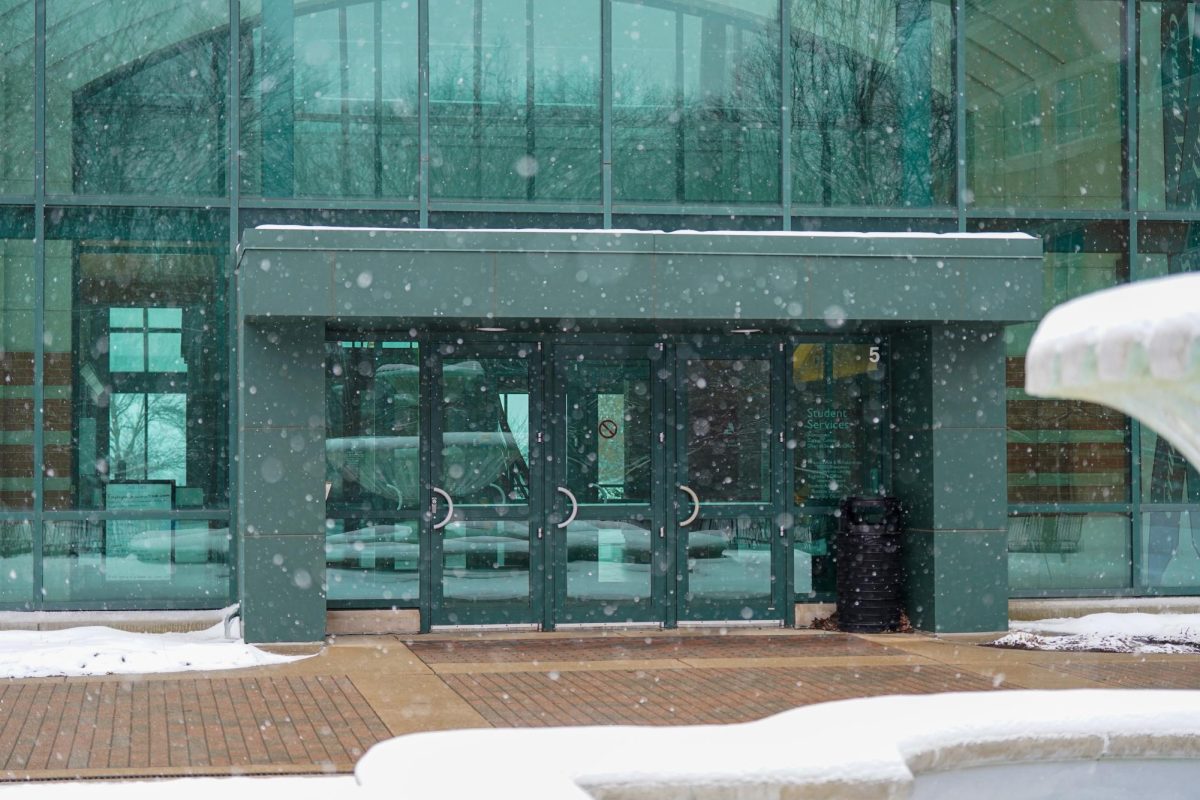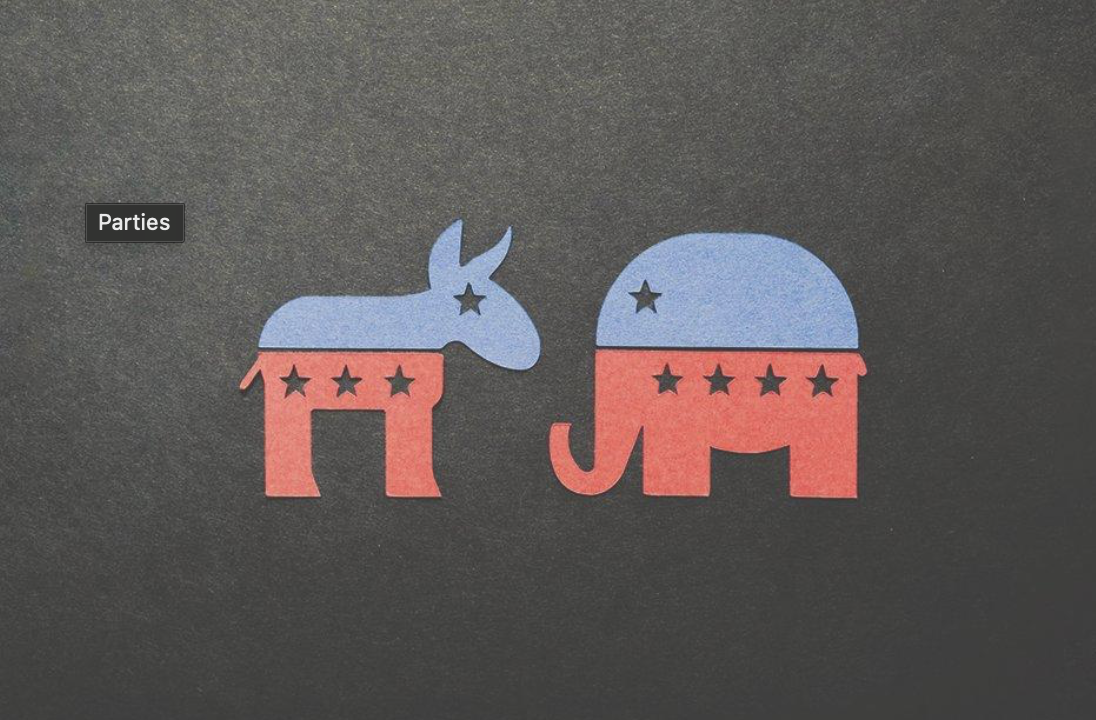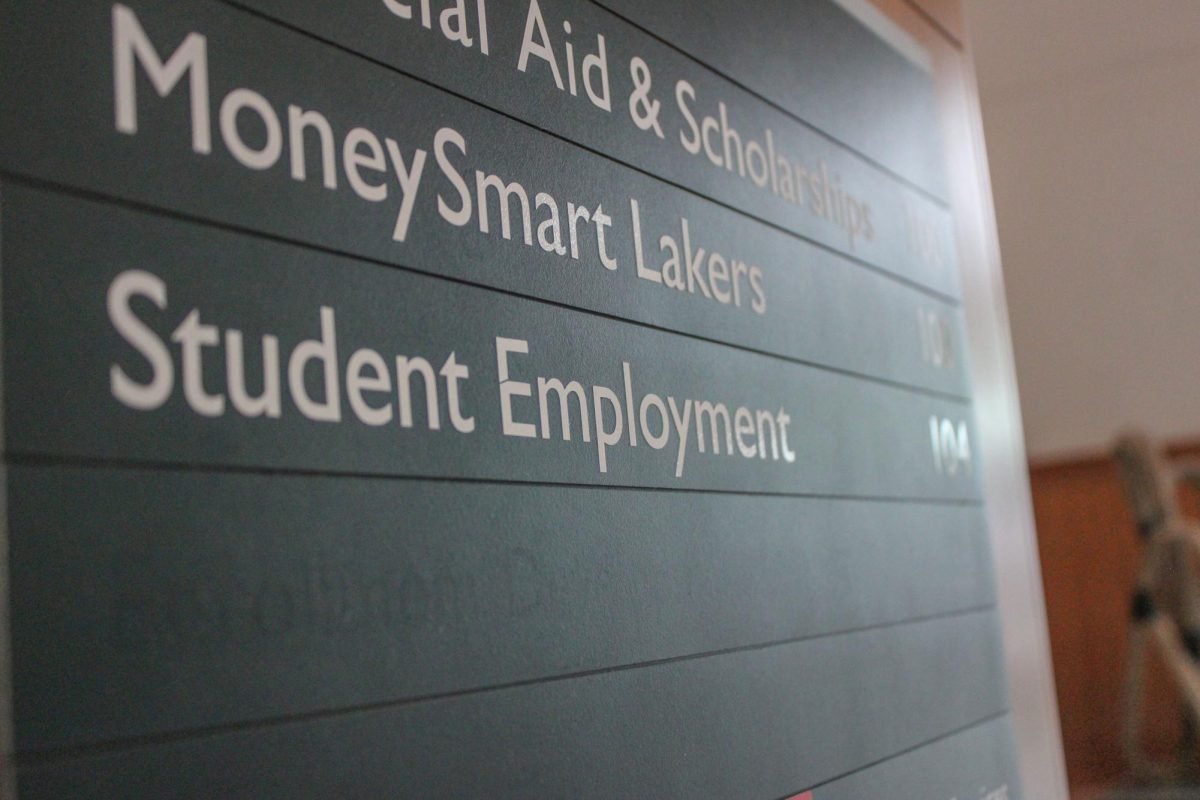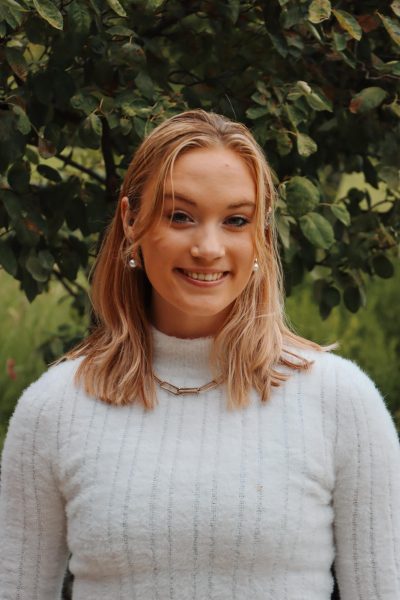GR air quality plummets, climate change plays role
Air pollution reached an all-time high for the city of Grand Rapids over the summer of 2023. Reaching a peak point in late June, the city held the worst air quality in the United States. Visible smog and haze blanketed the entire state for multiple days, caused by chronic pollution issues and the rampant wildfires in Northern Michigan and Canada.

One particular wildfire, near Staley Lake, Michigan, began as an unconfined campfire that burned over 2,400 acres of land. The smoke from this and Canada’s wildfires made their way across the Great Lakes to settle in the air. The wildfires created a perfect storm of hot temperatures, low precipitation, dirt and dust that coalesced into a remarkably poor season for air quality. Many experts in the scientific community feel the uptick in negative natural phenomena has a direct correlation to the effects of years of climate change.
According to Elena Lioubimtseva, a Professor of Geography and Sustainable Planning at Grand Valley State University, extreme wildfires and record-breaking air pollution are just the beginning of what could be the future effects of climate change. Acute causes in air quality change can be attributed to the wildfires, though the greater sum of these forest fires can be followed back to man-made causes.
To read more of Joseph Poulos’ story about record-low air quality in Grand Rapids, click here.
Campus housing overflow causes crowding, conflict
With more than 7,000 incoming students and even more returning students coming to Grand Valley State University this fall, Housing and Residence Life is facing new on-campus housing challenges.
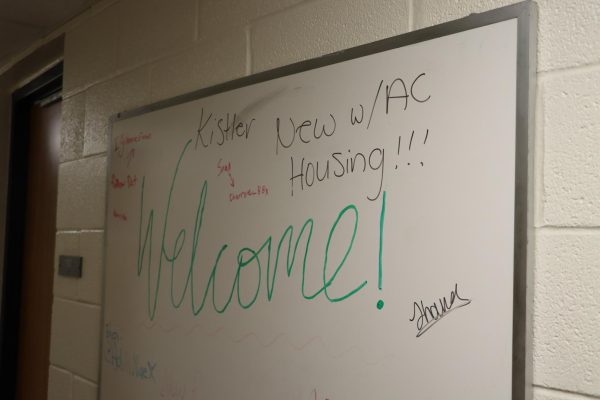
GVSU’s residence halls are over capacity. The influx of students signed to campus living contracts caused GVSU’s Housing and Residence Life to make adjustments to existing housing structures to increase room occupancy. This meant putting students in make-shift rooms in converted halls and lounges and housing more than 100 students in off-campus apartments leased by the university. How the university has addressed and managed the issues related to overcrowding has created new challenges for life on campus.
Residents who were either willing or required to live on campus are feeling the effects of the increased student population.
To read more of Elizabeth Schanz and Emma Armijo’s coverage of overcrowding in campus housing, click here.
Ottawa County budget meeting ends with slashed funds, legal uncertainty
After weeks of deliberation, the Ottawa County Board of Commissioners reached a decision about the budget for the Ottawa County Department of Health for the upcoming fiscal year. While the meeting was happening, the Chair Commissioner Joe Moss electronically served Health Officer
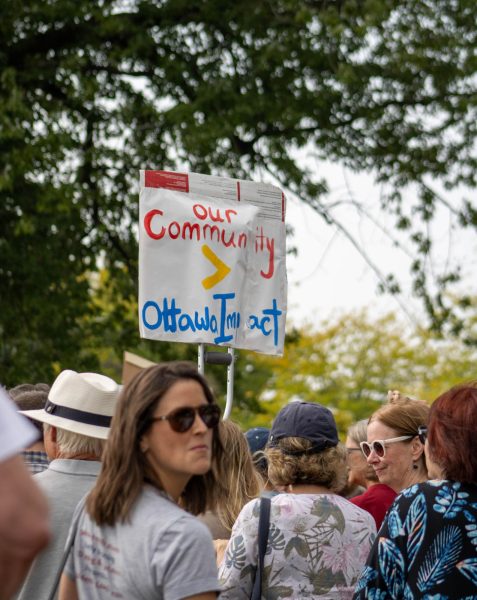
Adeline Hambley’s legal team notification of his filing for her removal.
During the seven-hour session that lasted until nearly 1 a.m. on Sept. 27, county representatives spent over two hours listening to residents’ opinions on the budget cuts. Many of these commenters came directly from a community rally against the cuts which occurred outside the health department prior to the meeting.
The final budget passed several hours later in a 7-to-3 vote, a figure $1.6 million lower than the initial general fund request from the health department of $6.4 million.
To read more of Grace Smith and Emma Armijo’s coverage of the conflicts surrounding the Ottawa County Department of Health and the Ottawa County Board of Commissioners, click here.
Bioethics professor overcomes challenges, immunocompromisation
Meegan Zickus is a professor of Biomedical Ethics (bioethics) at Grand Valley State University who suffers from a rare autoimmune disease called Necrotizing Autoimmune Myopathy (NAM). NAM is a disease characterized by “necrosis, or cell death, in the muscles, which causes weakness and fatigue.”

Though this condition has altered the way Zickus is able to interact with students, her passion for teaching and appreciation for learning contribute to her continued perseverance and her ability to be asset to her students on campus. Zickus spends her time teaching bioethics courses online, connecting with students and helping the law community through events like, “Know Your Rights” on campus.
Zickus began working at GVSU eighteen years ago, teaching both biology and bioethics. Zickus, a GVSU Alumna with a history in law, said she never pictured herself where she is today.
To continue reading Mallory Burt’s profile on Zickus, click here.
Sticker shock: why are GV C-Store prices so high?
Grand Valley State University’s campus stores sell products to students at heavily inflated rates, sometimes as high as about 360% more then the item’s original market value.
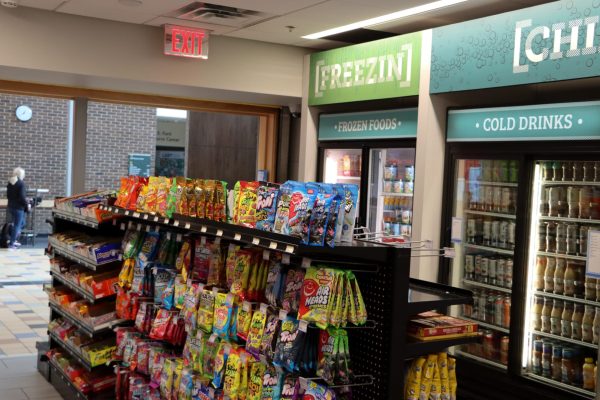
Clare Meteer, a Grand Valley State University senior majoring in Business Management and Dance, recently noticed she needed allergy medication. Meteer does not have a car and had very little time in between classes, so she decided to go to the Kirkhof Center C-Store, a convenience store on campus that is part of GVSU’s Laker Food Co., formerly known as Campus Dining, to buy some Claritin.
In a hurried state, Meteer grabbed the only box of Claritin. The register rang her up $5.29 before tax; she paid and went on her way. Later, she opened the box to find only one tablet. Meteer was shocked that she spent $6 on a single tablet of medicine that she had no other way to access on campus.
Frustrated, Meteer decided to look on Amazon. A ten-pack of Claritin costing about $10 equated to about $1 a tablet, versus the $6 she paid at the C-Store on campus.
To read more of Elizabeth Schanz’s coverage of campus stores inflated prices, click here.
How GV is Navigating NIL for Student Athletes
Two and a half years ago the groundbreaking Supreme Court ruling, NCAA v. Alston, prompted the National Collegiate Athletic Association (NCAA) to establish policies allowing college athletes to profit off of their name. Ever since the NCAA opened the floodgates of the Name, Image, and Likeness world, there has been open-ended possibilities of NIL are evident to college athletes at all divisions.
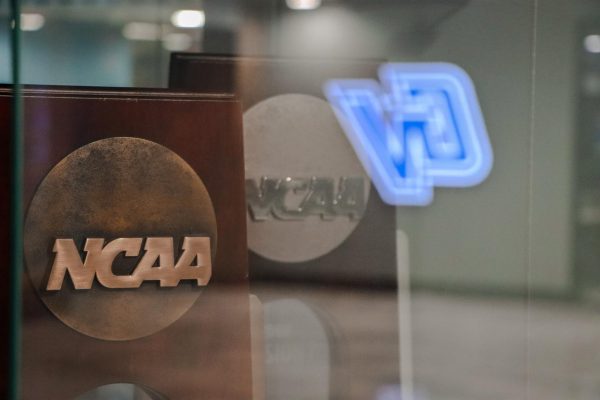
The benefits of NIL agreements are apparent for many Division 1 college athletes. For instance, Livvy Dunn, a gymnast at Louisiana State University has accumulated an estimated $3.5 million annually as of 2023 through NIL agreements. However, that’s not the reality for all student-athletes, especially those below Division I who are navigating this new environment in search of ways to stand out.
Grand Valley State University golfer Charlie DeLong has burst into the world of NIL by signing a total of three agreements within 2023 that have netted him an estimated $13,000 so far for his services. Although a pittance compared with Dunne’s haul, DeLong’s earnings account for more than a quarter of all NIL money earned by GVSU athletes.
To read more of Bethann Long’s coverage of the reality of NIL agreements for student-athletes at GVSU, click here.
Winter weather wreaks havoc on The Rapid’s routine
Grand Valley State University’s Transportation Services consists of a bus system that is commonly used by students. Whether students use the buses to get to and from their off-campus apartments to the Allendale campus, or to travel between the Allendale and Pew campuses, many students depend on the buses daily.
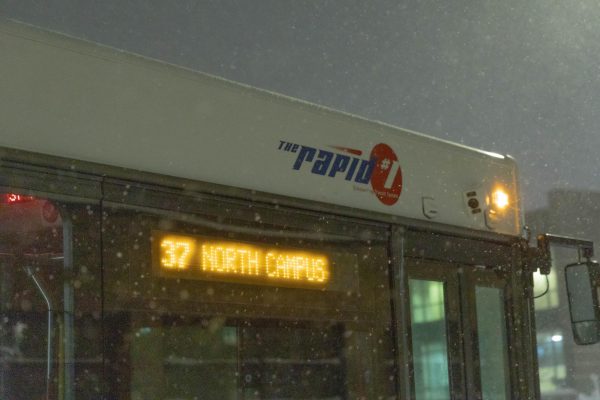
There are four different bus lines that service GVSU: the Laker Line that travels between the Allendale and Pew campuses, the 48 line (the South Campus apartment shuttle), the 37 (the North Campus apartment shuttle) and the 85 for weekend service.
Recent winter storms brought severe weather and high snowfall across Michigan. In lieu of the 11-19 inches of snow Allendale and surrounding areas received, GVSU’s Rapid buses experienced difficulties and unpredictable situations on the roads.
To read the rest of Natalie Brooks’ story about riding The Rapid in extreme winter weather, click here.
Report reveals health fields dominate GV’s most popular majors
Data from Grand Valley State University’s Division of Enrollment Development and Educational Outreach revealed the most popular majors on campus this semester are health driven. Despite the popularity of business-related fields, the division’s Winter 2024 Enrollment Report shows students are more interested in giving back to the community.

The report breaks down GVSU’s student body by class standing and focus of study. These numbers help guide GVSU in its growth and provide insight to student life. According to the report’s data, the top five studied undergraduate majors at GVSU are psychology, nursing, exercise science, education and marketing. The most popular of these majors is psychology, with over 1,000 students enrolled in the major this semester.
“The reason that people are so interested in psychology is because psychology is about understanding humans, human thought, human emotion, human behavior. All of us want to understand ourselves better and understand people that we care about in our life,” said Mary Bower Russa, Department Chair of Psychology at GVSU.
To read more of Eva Ortiz’s story about the most popular majors at GVSU, click here.
VMA programs are in a pinch for space
A quiet calm falls over the studio as students peacefully talk amongst themselves while spinning, sculpting and glazing their ceramic creations. However, the peaceful focus that many students find through ceramics is becoming harder and harder to spin.
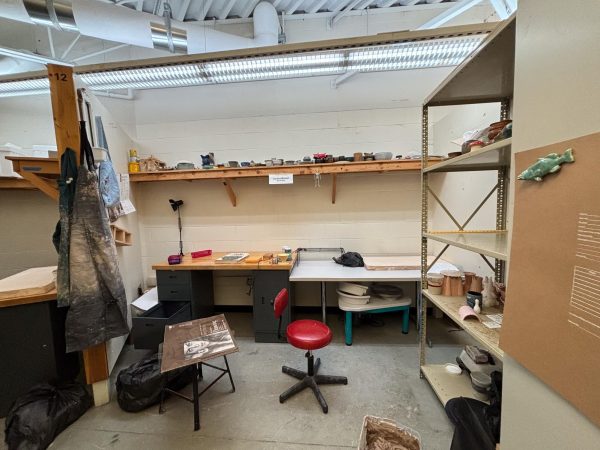
Large academic departments often share facilities, but at Grand Valley State University it seems the Department of Visual & Media Arts (VMA) is competing for space. The ceramics program at GVSU is navigating several issues after a portion of its allocated studio space was cut to make room for demands within other areas of VMA, lack of accommodations and long-term effects of a university department merger in 2018.
In 2018 the arts and design department, including ceramics, merged with film and photography, creating the Department of Visual Media Arts. This made it so that decisions around studio space could be moved around between these programs. They now have to operate under one common administrative group within the College of Liberal Arts and Sciences (CLAS), share facilities and share an overarching budget.
To continue reading about Emma Armijo and Isabelle England’s story on the VMA department’s classroom crossover, click here.
GV students promote inclusivity, awareness through free American Sign Language classes
To support the Deaf and hard-of-hearing community, Grand Valley State University is offering a free class dedicated to teaching American Sign Language.
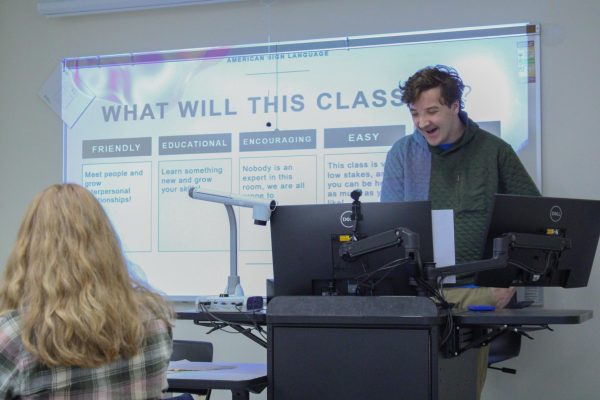
The course not only instructs attendees in American Sign Language (ASL) but also integrates educational material centered on the cultural dimensions of the Deaf and hard-of-hearing community.
The class was organized by Austin Matlis, a student at GVSU who has been signing his entire life, and Mae Zurita, a Graduate Assistant in the Office of Multicultural Affairs and a frequent participant in the course. Matlis, who teaches the class, was born to two deaf parents and is a freshman studying social work, an experience which he feels has taught him useful teaching skills.
“I’ve learned how hard it is to live in a hearing and a deaf world, and using that experience, I’m here now,” Matlis said.
To read more of Nolan McKendry’s coverage of free ASL classes on campus, click here.
Admissions aftermath: GV faculty feel pressure to aid underprepared students
For the third consecutive week, the Grand Valley State University Academic Senate (UAS) met to discuss ongoing matters concerning GVSU admissions. The two-and-a-half-hour meeting on Feb. 16 at the Cook-DeVos Center for Health Sciences gave UAS representatives the opportunity to engage in an open dialogue about the effects of GVSU’s increased admission of underprepared students.
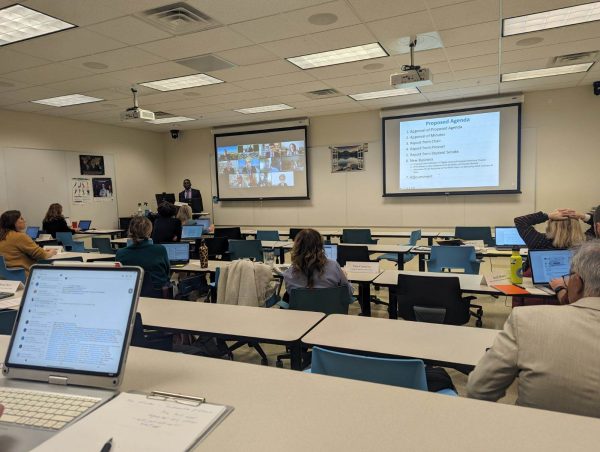
GVSU faculty members that serve on UAS detailed their experience of acting as the first responders for students who are ill-prepared to succeed at GVSU. Since they are the ones on the front lines in classrooms and lecture halls across campus, UAS representatives have seen firsthand the consequences of GVSU’s increased admission of students with GPAs below 3.0. This has led faculty to change curriculum, introduce competency based-grading systems for courses and increase office hours to accommodate struggling students.
In the consideration of time and organization, the meeting was structured into three sections. A 30-minute period was given to UAS representatives to lay the foundation for admissions discussions followed by a 30-minute response from Strategic Enrollment Management Plan (SEMP) faculty and leadership. The remaining hour and a half was set aside for a question-and-answer session that was open to all.
To continue reading Arts & Entertainment Editor Dylan Hoffius’ coverage of admissions fallout in UAS meetings, click here.
Students express anger, confusion towards GV Police Academy relocation plan
During the Grand Valley State University Board of Trustees (BOT) meeting on Feb. 23, it was announced the GVSU Police Academy will be relocated from the Allendale Campus to Holland’s Meijer Campus. This move was proposed to meet the demands for law enforcement training and education, and will cost almost $6.5 million in renovations.
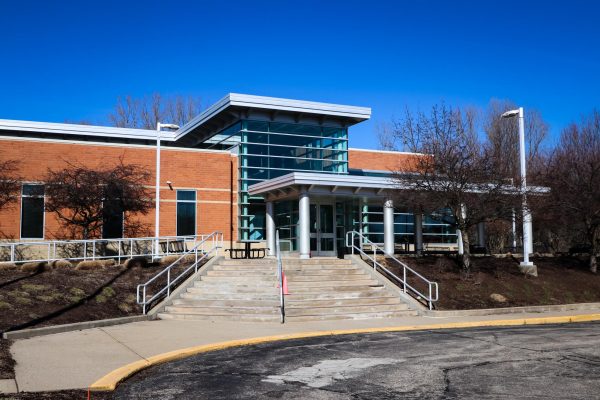
The project includes the addition of classrooms, scenario rooms, a multipurpose room, a weight room, a mat room, locker rooms, a computer lab and an exterior driving course for instruction and performance evaluations. Relocating the police academy utilizes the space on the Holland Campus, which was closed to the public in 2020 and according to GVNext,had been utilized for COVID-19 vaccination clinics. However, some students are concerned about how University resources are being allocated to support this project.
The police academy was founded in 1974. The program averages 35-40 recruits per session which are eight weeks or 15 weeks in length. According to the academy, it has a 99% licensure exam pass rate, a 96% completion rate and a 96% employment rate.
To read more of Mason Cordell’s coverage of student reactions to relocating the GV Police Academy, click here.
Violence against trans community sparks LGBTQ activism
Protests and vigils have been held to support the safety of transgender individuals nationwide. On Sunday, March 31, a vigil was held at Grand Valley State University’s Cook Carillon Tower for Nex Benedict, a 16-year-old non-binary student from Oklahoma who lost their life due to transphobia. The vigil was organized by GVSU’s Students for a Democratic Society (SDS) to commemorate Trans Day of Remembrance.
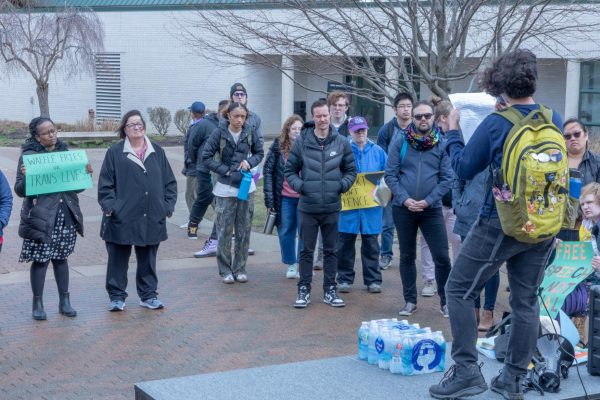
The day honors the lives that have been lost due to transphobic aggression and legislation. GVSU students attended the vigil for Benedict and the “Out! Loud” assembly on March 26 at the Cook Carillon Tower to advocate for trans safety.
“To honor the lives of those who have died because of trans violence, such as Nex Benedict, our movement needs to carry their names and spirits forward, to not forget them and to demand that those who commit violence against trans people face severe consequences,” said SDS Vice President Owen Frassetto. “When that small section of society who hates trans people see that their violence is met with justice, they will be scared off.”
To read the rest of Max Bufkin’s story about trans activism on campus, click here.
GV student death, lack of University response voiced at student-led town hall
A student-led town hall called “Retention, Representation, and Racism” was held on April 2 focusing on issues of discrimination and diversity at GVSU. The town hall gave students who identify as Black, Indigenous and people of color (BIPOC) a chance to share their concerns with University leadership. With the ability to share stories with the Senior Leadership Team (SLT), other campus concerns were voiced.
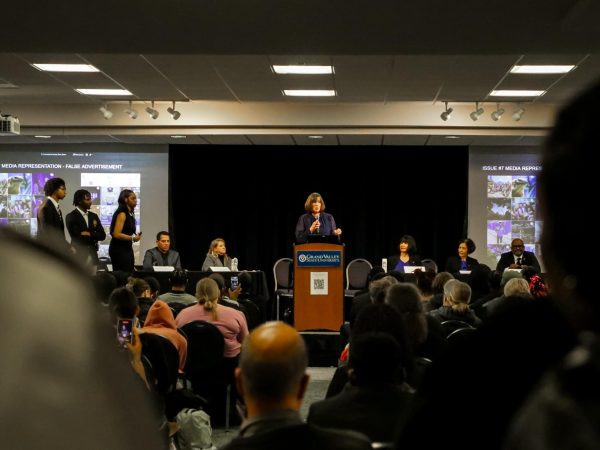
One story came from GVSU student speaker Zuri Caldwell who spoke about a friend, Carrington Johnson, who attended GVSU and recently passed away. At the town hall, she told Johnson’s story and expressed her frustration towards the University for not acknowledging her friend’s passing.
Caldwell said she received little to no support or accommodation from the school during her time of mourning.
To read more of Max Bufkin’s story, click here.





